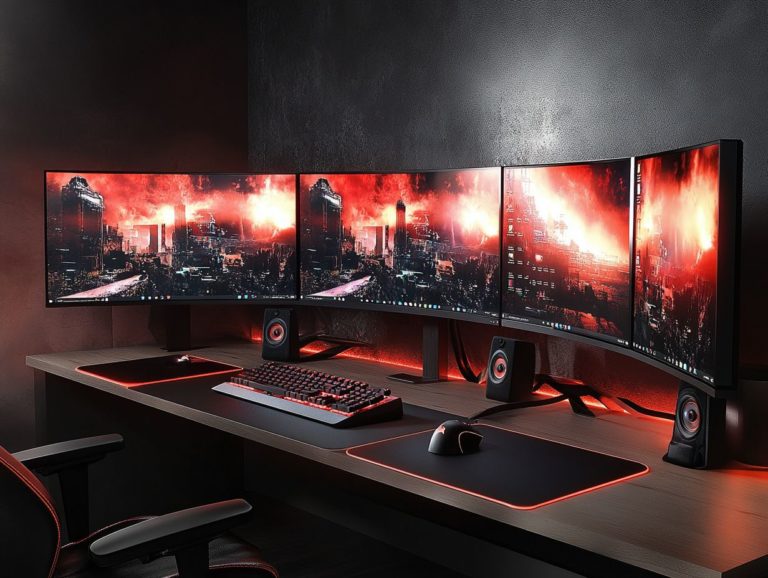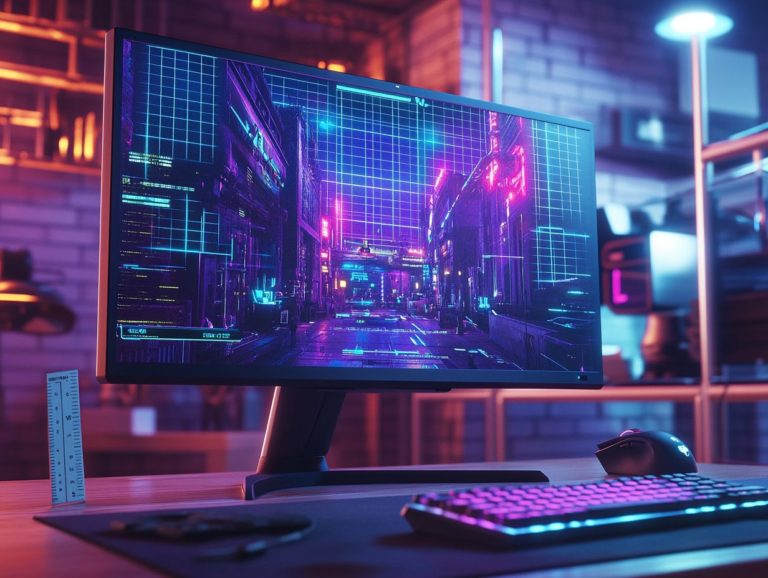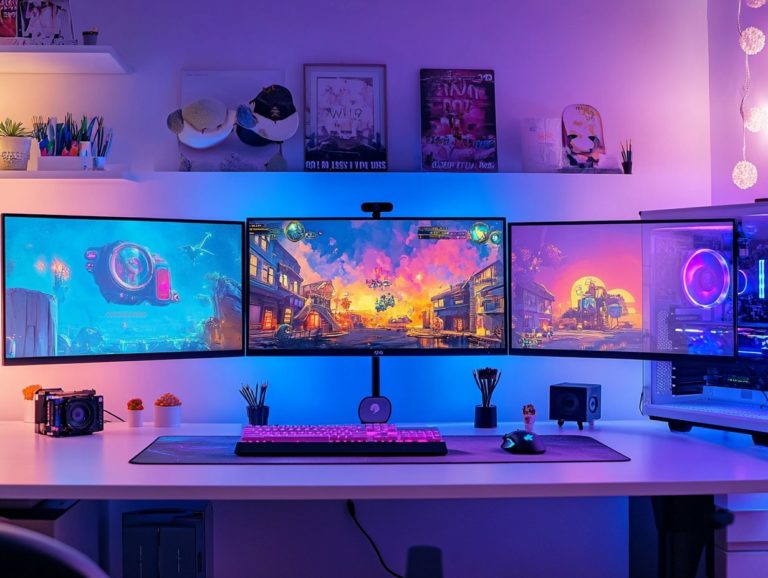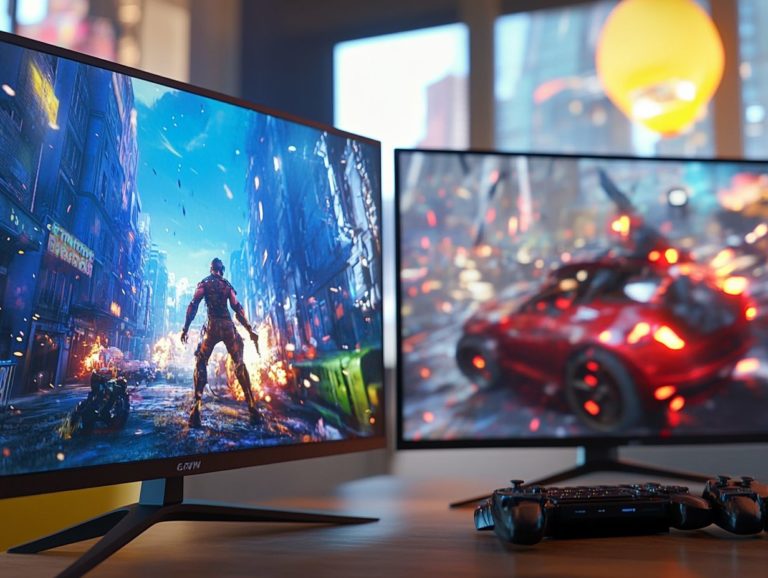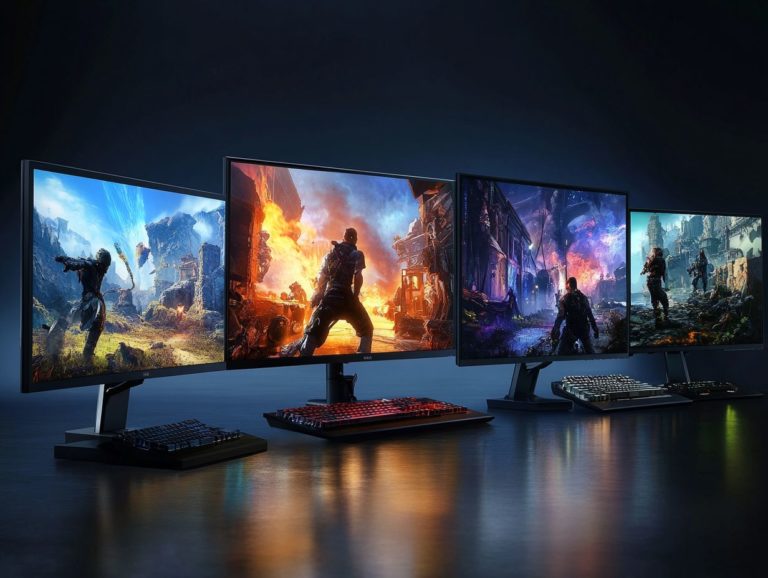understanding the basics of gaming monitor specs
Selecting the right gaming monitor is vital for an immersive gaming experience, yet the many specifications and features can feel daunting.
This guide will clarify the essential elements of gaming monitor specs, such as resolution, refresh rate, and response time, empowering you to make informed choices. You ll also delve into aspects like size, aspect ratio, and additional features like adaptive sync and HDR.
Plus, the technical jargon will be simplified, ensuring you can confidently select the perfect monitor for your setup!
Contents
Key Takeaways:
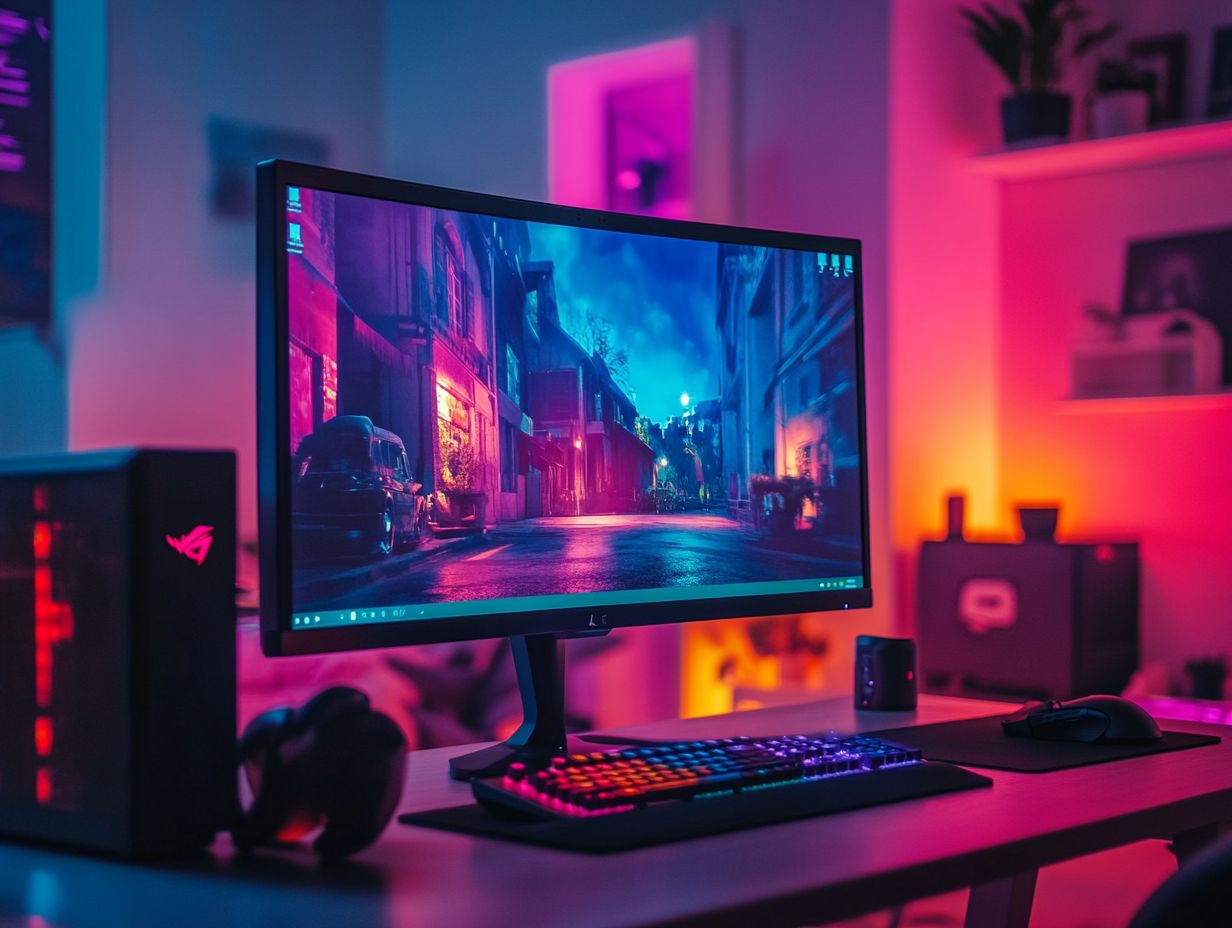
Understanding gaming monitor specs is crucial for optimal gaming experience. Resolution, refresh rate, response time, and input lag (the delay between your action and the monitor displaying it) are key features to consider when choosing a gaming monitor. Pay attention to monitor size, aspect ratio, adaptive sync, HDR, ergonomics, connectivity, and technical jargon when making a decision!
What are Gaming Monitor Specs?
Gaming monitor specifications are essential factors that define the quality and performance of your display. They influence everything from your gaming experience to your overall enjoyment of PC gaming.
Key specs like resolution, refresh rate, response time, and pixel density determine how effectively your graphics card can render high-end visuals. This ensures smooth gameplay with minimal visual artifacts.
Whether you re a casual player or an avid gamer, grasping these specifications will enable you to select the perfect gaming monitor tailored to your needs.
Among these specs, resolution types such as 1080p, 1440p, and 4K significantly impact the clarity and detail of the images on your screen. Higher resolutions like 4K offer sharper visuals, making them ideal for immersive gameplay, while 1080p remains a popular choice for its commendable balance between performance and quality.
Refresh rates, such as 240Hz and 360Hz, enhance the fluidity of motion on-screen, with higher numbers resulting in reduced motion blur and smoother transitions. Response times, typically measured in milliseconds, are crucial in minimizing lag and ghosting during fast-paced scenes.
Together, these specifications not only elevate your overall visual experience but also provide you with a competitive edge in fast-paced gaming scenarios!
Key Features to Consider
Choosing a gaming monitor? Focus on these key features for an amazing experience! Refresh rate, response time, and display resolution are fundamental to crafting an immersive gaming experience.
High dynamic range (HDR) enhances visuals. Adaptive sync technologies such as G-Sync and FreeSync, along with various panel types including IPS, TN, and OLED greatly influence how visuals are rendered on your screen, ultimately shaping your overall gaming performance.
Whether you re diving into high-end graphics or seeking budget-friendly options, grasping these features is essential for making informed choices that elevate your gaming experience!
Resolution and Refresh Rate

When you’re in the market for a gaming monitor, resolution and refresh rate are the key factors that will shape your entire gaming experience. The display resolution whether it’s 1080p, 1440p, or 4K determines how sharp and detailed your visuals will be. Meanwhile, refresh rates of 240Hz or even 360Hz create a seamless environment, free from motion blur or tearing.
In the ever-evolving world of gaming, starting with a 1080p monitor is a solid choice. It offers good graphics and competitive performance, making it perfect for those just embarking on their gaming journey. If you’re a more experienced gamer looking to elevate your experience, stepping up to 1440p will deliver sharper visuals without straining your graphics card as much as 4K does!
Although 4K monitors provide breathtaking detail, they demand significant processing power to maintain high frame rates, which can be a drawback for fast-paced competitive games. This is where refresh rate shines: higher rates not only smooth out motion but also sharpen your reflexes, giving you a competitive edge in heated multiplayer matches.
Thus, carefully weighing these specifications is crucial for achieving the perfect balance of visual fidelity and competitive advantage!
Response Time and Input Lag
Response time and input lag are crucial specifications in a gaming monitor, especially for competitive gaming. Every millisecond counts! A lower response time reduces visual artifacts and ghosting, giving you a more responsive and immersive experience.
Reducing input lag ensures your actions appear seamlessly on the screen, which is essential in fast-paced gaming scenarios.
In competitive gaming, even a tiny delay can mean the difference between winning and losing! You can rely on features like G-SYNC and FreeSync, which help keep your game visuals smooth by synchronizing your monitor’s refresh rate with your GPU s output.
Choosing TN or IPS panels with faster refresh rates can elevate your performance. The perfect mix of low response time and reduced input lag sharpens your reaction times and gives you a tactical edge, enhancing your overall gameplay experience.
Choosing the Right Size and Aspect Ratio
Selecting the ideal screen size and aspect ratio can greatly enhance your gaming experience! A bigger screen can immerse you in a visually captivating environment.
Whether you prefer classic 16:9 displays or want to explore ultrawide monitors that expand your field of view, consider your gaming setup, personal preferences, and favorite genres.
Curved displays also have distinct advantages. They enhance immersion and improve viewing angles, making these factors crucial for any serious gaming enthusiast.
Factors to Consider
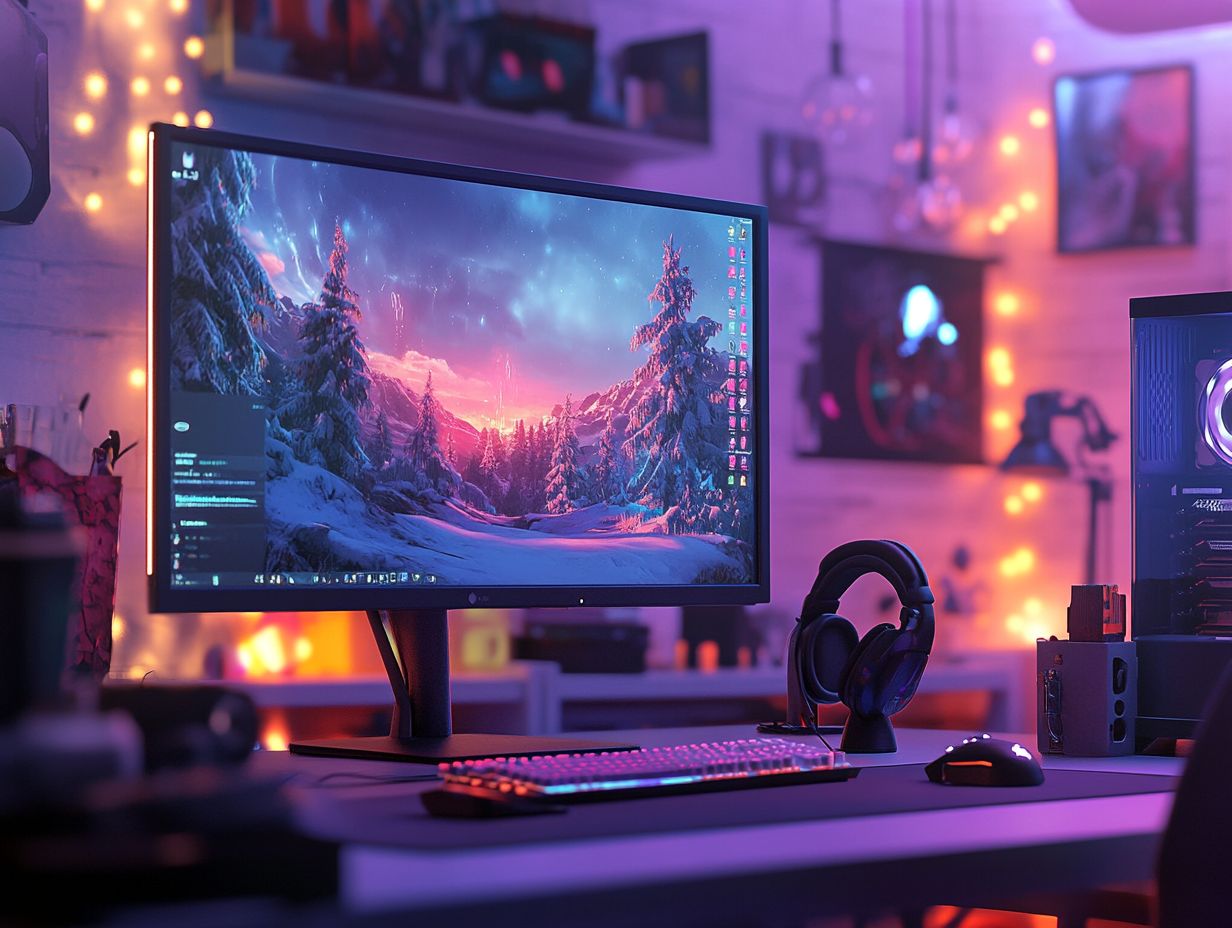
When determining the best screen size and aspect ratio for your gaming monitor, consider several factors like viewing distance and your specific gaming setup.
The distance from which you view the monitor can greatly affect how sharp and immersive your gaming experience feels. Competitive gaming requires different considerations compared to casual play, as visual clarity can directly influence your performance.
If you’re diving into fast-paced esports, a smaller screen with a higher refresh rate may suit you best. This setup ensures every frame is crisp and responsive, aiding those split-second decisions that can make or break a game.
As a casual gamer, you might prefer a larger display for comfortable viewing from a distance. This enhances your enjoyment of expansive open-world environments, letting you soak in the details without straining your eyes.
Your personal preferences also matter! Some players love the immersive cinematic experience a wider aspect ratio provides, while others prioritize quick reactions in competitive scenarios.
Understanding these dynamics helps you make informed choices that elevate your gaming experience.
Additional Features to Look For
Beyond the essential specifications, several additional features can significantly enhance your gaming experience! Explore options like adaptive sync, HDR capabilities, and ergonomic designs.
Features such as G-SYNC and FreeSync can eliminate screen tearing, ensuring a smoother gameplay experience. High dynamic range technology improves color depth and contrast, adding richness to your visuals.
Don’t overlook connectivity options; they are vital for seamless integration into your gaming setup, allowing you to fully immerse yourself in your digital world.
As you shop for gaming monitors, keep these features in mind to make the best choice for your gaming needs!
Adaptive Sync and HDR
Adaptive sync technologies like G-Sync and FreeSync are essential for smooth gameplay. They reduce tearing and elevate your overall performance.
HDR, or High Dynamic Range, improves picture quality by offering a wider range of colors and better contrast. This results in vibrant and lifelike images during your gaming sessions.
These technologies sync your monitor s refresh rate with the frame rate from your graphics card. This eliminates visual artifacts that occur when these rates go out of sync.
If you’re a gamer engaged in fast-paced scenarios, this means a fluid experience. It also gives you an edge in reaction time and precision.
HDR enhances both dark and bright scenes, ensuring that you don’t miss details in shadows or highlights. Immerse yourself in richly textured environments for a visually rewarding gameplay experience.
Ergonomics and Connectivity
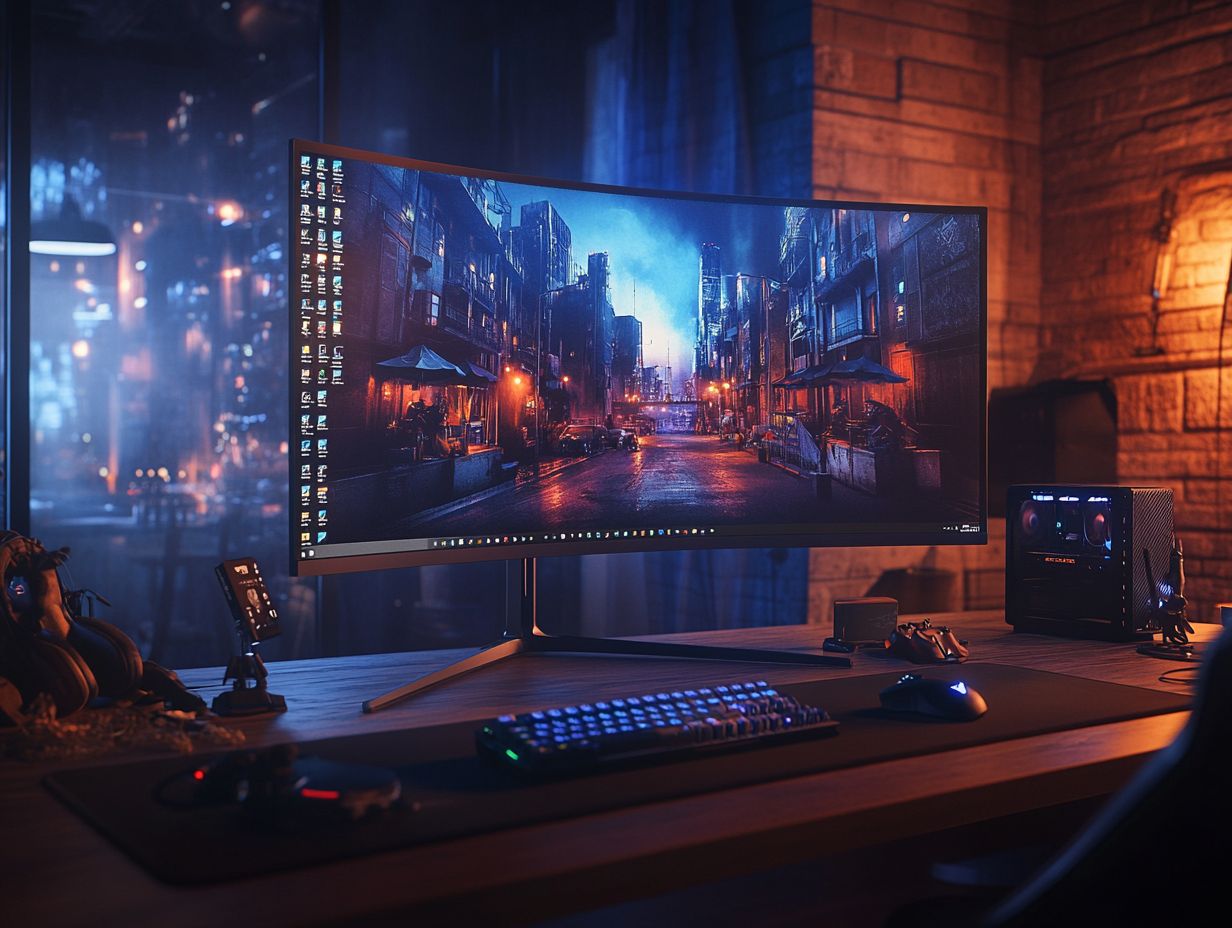
When choosing a gaming monitor, ergonomics and connectivity are crucial. They play a big role in enhancing your gaming experience.
A monitor with adjustable height, tilt, and swivel features can reduce strain during long sessions. Having various connectivity options like HDMI, DisplayPort, and USB-C makes it easy to integrate your monitor into any setup.
These features promote better posture and allow you to customize your view. This helps you maintain focus during intense gameplay.
For instance, USB-C allows for fast charging and data transfer. DisplayPort offers high refresh rates for clearer visuals.
By prioritizing ergonomic designs and versatile connectivity, you can boost your performance and comfort. This paves the way for immersive experiences that keep you engaged for hours.
Understanding Technical Jargon
Understanding the terms related to gaming monitors is key for making informed purchases. Familiarizing yourself with essential features of a gaming monitor can elevate your gaming experience.
Familiarize yourself with important terms like pixel count, color range, and refresh rate. This will help you evaluate the benefits of various monitor features.
With this knowledge, you can choose options tailored to your unique gaming needs.
Decoding Common Terms and Acronyms
Knowing the common terms and acronyms for gaming monitors is crucial. This knowledge helps gamers improve their setups. Understanding terms like IPS, TN, OLED, and pixel density can significantly influence your monitor choice. These factors affect everything from color accuracy to response times.
For example, IPS, or In-Plane Switching, is celebrated for its exceptional color reproduction and wide viewing angles. This makes it an ideal selection for immersive gaming experiences.
Conversely, TN, or Twisted Nematic panels, tend to be more budget-friendly and offer quicker response times. This can be appealing for competitive gamers.
Then there’s OLED, which stands for Organic Light Emitting Diode. It provides stunning colors and deep blacks, but it may come with a heftier price tag.
Understanding pixel density is just as critical. Pixel density refers to how many pixels fit in a square inch. Higher pixel density means sharper images.
By familiarizing yourself with these terms, you can make informed decisions that will enhance your gaming experience.
Frequently Asked Questions
What are the most important specs to consider when looking for a gaming monitor?
The most important specs include refresh rate, resolution, response time, panel type, and connectivity options. These affect your overall gaming experience.
What is the ideal refresh rate for a gaming monitor?
The ideal refresh rate for a gaming monitor is 144Hz or higher. This means the screen will refresh 144 times per second, providing a smoother and more fluid visual experience.
How does response time affect gaming performance?
Response time is the time it takes for a pixel to change from one color to another. For gaming, a lower response time is better as it reduces motion blur and ghosting, resulting in a more responsive and accurate image.
What is the difference between TN, VA, and IPS panel types?
TN panels have the fastest response times but poorer viewing angles and color accuracy. VA panels offer better color accuracy but have higher response times. IPS panels provide the best viewing angles and color accuracy, but they can be more expensive.
Do I need a specific graphics card to take full advantage of a high-resolution gaming monitor?
Yes, a powerful graphics card is recommended for high-resolution gaming monitors. The higher the resolution, the more demanding it will be on the graphics card to produce smooth and high-quality visuals.
Can I connect multiple gaming monitors for a larger display?
Yes, many gaming monitors have options for multiple connectivity, such as HDMI and DisplayPort. This allows you to connect several monitors for an extended or dual display setup.

